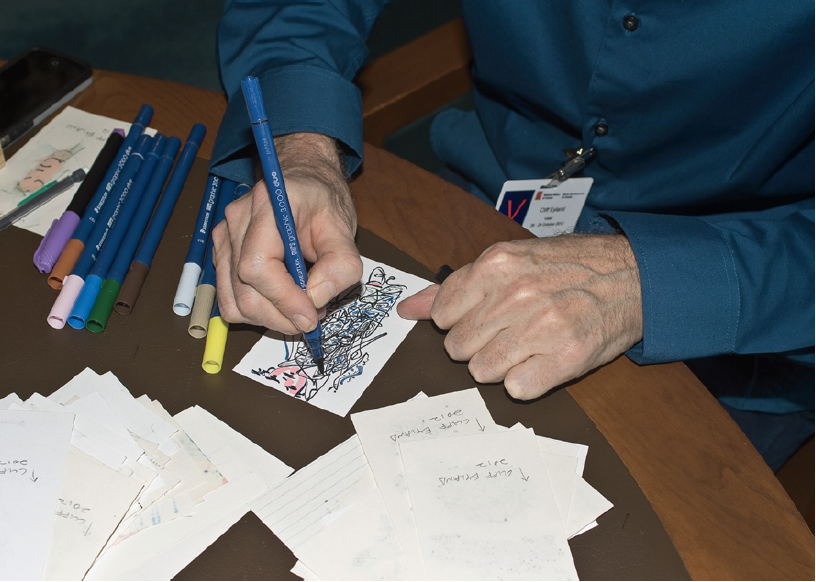Cliff Eyland
Cliff Eyland is an artist whose love of the absurd and the surreal has yielded countless drawings over his career. A bibliophile and archiver, Eyland has made literature a primary source of inspiration for his prodigious output. Eyland also seems like he was the kind of kid who would have ravished the blank margins of library books as free game for his quick pen and wild imagination.

Cliff Eyland, three-day weekend residency at the Library & Archives, National Gallery of Canada, Ottawa, October 26 to 28, 2012. Images courtesy the National Gallery of Canada. Photography: Michael Williams.
The library has remained the mainstay of his aesthetic preoccupation, to which he returns again and again as both the source of his inspiration and as artistic focus. Cliff Eyland’s residency, from October 26th to the 28th at the National Gallery of Canada’s Library & Archives, became an opportunity for the artist to gently intervene into the function, procedure and purpose of the library. The Archives have taken on the responsibility of charting the development of the visual arts in Canada since the founding of the National Gallery in 1880. Headed by Peter Trepanier, the Library & Archives houses over 275,000 books and periodicals, including special collections of rare and illustrated books and one thousand linear metres of institutional archives and private papers. It also contains artists’ books and multiples (including the Art Metropole Collection), archival materials such as sketchbooks, journals and letters. The setting itself has an ordered, serene quality to it, a sanctuary cherished by those who want to get away from the distractions of the city and indulge in a rare find. The reading room is a spacious, pristine environment fitted out with large tables overlooking the St. Lawrence River. Books are by request only, similar to other more traditional institutional archives, and are brought to you from the stacks by assistants.
Eyland’s response to the library is sincere, even reverential. Rather than use the pages of borrowed books as his support, he does one better. He has restricted himself to using the three-by-five-inch index card format as his primary outlet for the past three decades. He thinks of this format as “being like one cubist facet broken off from a larger painting, the way a hologram breaks up. In a hologram, each fragment contains a whole image.” The set of one thousand index cards drawn during his residency was created to be placed between the pages of library books and found (for keeps!) by those lucky enough to have it housed in one of their requests. Many are now displayed in a handmade box made to resemble an index card drawer—that other pre-digital-age-method of cataloguing.

Cliff Eyland, “Smartphones,” vitrine exhibition at the National Gallery of Canada, 2012. Image courtesy the National Gallery of Canada, Ottawa. Photography: Michael Williams.
Eyland is a delightfully impish interlocutor for a growing cast of characters who seem to have wandered off his drawing table in search of their own story. The artist is ever aware that the nature of his drawing project is absurd. There is negation in his work born of a Dadaist impulse but grown by a “veneration for a fractured European tradition that includes everything from Renaissance art to Marcel Duchamp.” These unabashed free-form improvisations each seem to have been done in one sitting, put down quickly, almost impulsively, in order to short-circuit the conscious mind and remain as open as possible to the flow of imagery that exists just below its surface. The drawings begin as entangled ink gestures resembling script, put down automatically and seemingly without purpose, at first. Once these initial marks are in place, faces, hands and feet begin to emerge from calligraphic marks. Rather than arrange themselves into legible words, these gestural lines grow from swirls of staccato patterns to form a tragicomic parade of curlicued monster portraits, alien-like figures and cross-bred forms. With amalgamations of arabesques and quick ink flourishes, Eyland has created a procession of misfit characters reminiscent of the surrealist drawings of André Masson and Max Ernst.
His internal catalogue of received influence turns towards sculpture in a work titled “Smartphone Wallpaper.” Housed in a long vitrine, the work consists of 28 individual three-by-five-inch panels of painterly improvisations made from thick acrylic paint and found objects. These materials are recombined into endlessly different creations in no apparent order or preconceived design, where dollar-store bugs and gum packages are buttons, wires become ornate swirls of colour and dollops of paint stand in for protective smart phone cases. These fetishes of technology have been willfully manhandled, broken down and remade into playful redundancies. These “phones” represent the sprawling digital world beyond the physical archive, a world barely touched by the ordered intelligence and patient diligence that the library represents.
Eyland’s whimsical interventions remind us to see the library as a living archive built by hand, available to be activated by curious, but also mischievous fingers. ❚
Cliff Eyland’s three-day weekend residency was at the Library & Archives, National Gallery of Canada, Ottawa, from October 26 to 28, 2012. His vitrine exhibition was from October 26 to December 22, 2012. The drawings inserted into National Gallery Library books is on permanent exhibition.
Martin Golland is an Ottawa-based artist and Assistant Professor at the University of Ottawa.

